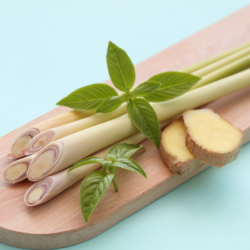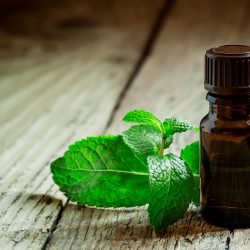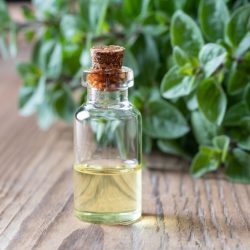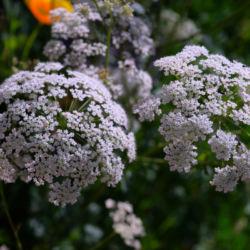Camphor rosemary, whose botanical name is Rosmarinus officinalis camphoriferum, belongs to the Lamiaceae family. Its essential oil is obtained from the flowering branches.
History of Rosemary
A symbol of love, marriage and death, ancient rosemary was used in religious rituals. It became a therapeutic plant in Arab medicine in the 10th century. Rosemary is a typical Mediterranean plant, which has been cultivated and used for a long time. It has a wide range of applications: aromatherapy, phytotherapy, perfumery, cooking, etc.
In ancient times
It would appear that rosemary had symbolic value very early on in antiquity. “An aromatic plant that became a funerary plant, its aroma was thought to preserve the body of the deceased, and its evergreen foliage seemed to be a guarantee of immortality”. Associated with a number of funeral rites, it accompanied the deceased into the afterlife. But it was also useful for the living during these rites, as we know that the Romans wore crowns of rosemary (hence its nickname of crown grass, coronarius) to help them keep a cool head during such events.
A symbol of love, marriage and death, rosemary was used in religious ceremonies in ancient times.
Rosemary and symbolism
Although sprigs of rosemary have been found in tombs dating back to the earliest Egyptian dynasties, there is no evidence that it had any such function. Perhaps it had the same role in Egypt as it did in ancient Greece and imperial Rome. Sources indicate that Greeks and Romans used the plant as a medicine, but nothing is less certain.
It would seem that rosemary had symbolic value very early on in Antiquity. “An aromatic plant that became a funerary plant, its aroma was thought to preserve the body of the deceased, and its evergreen foliage seemed to guarantee immortality”. Associated with a number of funeral rites, it accompanied the deceased into the afterlife. But it was also useful for the living during these rites, as we know that the Romans wore crowns of rosemary (hence its nickname of crown grass, coronarius) to help them keep a cool head during such events.
A symbol of death, it is also a symbol of life and love. It was therefore commonly used at weddings, always in the form of a crown. From the cult of the dead, we move on to the idea of rejuvenation and resurrection. But rosemary went from being a cultic plant to a medicinal and then a condiment, through a process of desacralisation, such as we see so often when we talk about plants . “But this unjust decline could only be temporary, since, after all, legends about plants were just a way of highlighting their virtues. We could say today that they were intended to engender a prior psychic conditioning that made their very real properties even more effective”.
This, too, is the magic that allows a remedy to work more or less well, depending on the attitude we adopt towards it. For example, it wasn’t enough for Greek students to weave wreaths of rosemary around themselves for their minds to be immediately stimulated (in the same way as we would do with an essential oil diffuser today). We need to rediscover the sacred nature of the plant, which centuries and centuries of denial and ignorance have erased.
A few medieval anecdotes:
Distillation separates the thin from the thick and recovers the “spirit of the plant”. This is what Archigenes attempted in the first century AD, using decoction. Later, it is said that the Arabs were the first to distil rosemary. In any case, rosemary produced an essential oil that was much appreciated by Renaissance spagyrists and apothecaries. Outside its geographical area of origin, rosemary was also widely cultivated in medieval gardens.
Finally, the Renaissance welcomed rosemary. It was admired from the sixteenth to the eighteenth centuries and was used in the vinegar of the Four Thieves. But above all, rosemary made the headlines in the 17th century, mainly through the waters for which the Queen of Hungary was very famous. This water, which is in fact an alcoholate, contains distilled rosemary flowers fermented with honey, and possibly turpentine and cedar wood.
It came into therapeutic use in Arab medicine in the 10th century, with indications reported by Ibn al-Baytar (13th century): “rosemary provokes the flow of urine and menstruation, resolves obstructions of the liver and spleen, purifies the lungs, and is useful for coughs, asthma, ascites and dropsy (water retention)”. The first distillations carried out in Montpellier date back to the 14th century. When used for massage, the camphorated oil is reputed to relieve muscular pain, while the cineole oil is a disinfectant and expectorant.
Distillation plays a part in this, separating the subtle from the thick and rediscovering the “spirit of the plant”. This is what Archigenes attempted in the 1st century AD, using a decoction. Later, it is said that it was the Arabs who first distilled rosemary. Although it is certain that this took place in the 14th century, sources are conflicting as to the identity of those who carried out the manoeuvre: was it the Arabs or Ramon Lull ?
Whatever the case, the result was an essential oil held in very high esteem by Renaissance spagyrists and apothecaries, but before we get there, a few medieval anecdotes about rosemary: Outside its original geographical area, rosemary was widely cultivated in medieval gardens. In fact, it is mentioned in the Capitulary of Villis (the territory of the Carolingian Empire extended far beyond the Mediterranean), as well as on the map of Saint-Gall, in Switzerland! Finally, Hildegarde talks a little about it and the Grand Albert mentions a recipe based on lavender, spearmint, marjoram and rosemary, already presented as “eau de jouvence”.
Rosemary was not just for the elite. It is part of the traditional pharmacopoeia of many southern countries. But it’s true that while popular wisdom sometimes has its good points, rosemary, cultivated, studied and used in monasteries, gradually entered the realm of the religious Christian. As a simple plant, it was particularly in the Middle Ages that it was recognised for some of its medicinal properties (helping memory, of which it is one of the symbols, fighting rheumatism, etc.). These properties have been illustrated in countless preparations over the centuries (eau de Dardel, baume Nerval, baume tranquille, alcoholate vulnéraire du Codex, baume nervin, rosemary ointment…).
From the Renaissance to the present day
Louis XIV also used it to relieve his rheumatism, while Madame de Sévigné praised it to her daughter, Madame de Grignan. In 1678, Madame Fouquet returned to the case of the Queen of Hungary in her Recueil des remèdes faciles et domestiques. She wrote that the queen washed her face with this elixir, which is said to have made her more beautiful..
In the 16th century, Jean Bauhin mentions what are known as Madonna herbs, i.e. those dedicated to the Virgin Mary. These included rosemary, “which probably owes its name to an ambiguity between marinus and marianus, or to a certain similarity between its foliage and that of the juniper tree that was used to hide the fugitive Virgin”.
In Latin, the scientific name for rosemary is rosmarinus, not rosmarianus. Rosemary therefore does not belong to Mary, even though it has been called her “tree”, but rather to the coasts of the sea. It has been said that the word rosmarinus can be broken down as follows: ros-marinus, ros meaning both “rose” and “dew”. Rosemary would therefore be a “marine rose” or a “marine dew” (the English rosemary and especially the German rosmarin leave no doubt on this point).
ChurchmanPaul-Victor Fournier tells us that ros is an old Latin word related to rhus, which means… bush. Etymologically, then, rosemary is nothing other than a maritime shrub. Which, incidentally, is quite obvious.
In the 20th century, Leclerc reported that rosemary was also a recommended stimulant for asthenia caused by infectious diseases. Macerated in mulled wine, it can be used as a poultice for swollen joints, sprains and bruises. The infusion is also beneficial as a mouthwash for tonsillitis.
In the past, a digestive drink was prepared by soaking rosemary in a bottle of red wine. As an infusion, rosemary is recommended during periods of biliary insufficiency, digestive problems, stomach aches, fatigue (e.g. after illness) or respiratory infections. Rosemary therapy has long been a popular springtime detoxification treatment. Rosemary is recommended topically to help heal wounds and relieve muscle and joint pain.
Although Valnet’ s novel is a little overdone with rosewater, it is nonetheless true that this elixir had the merit of curing this queen of the rheumatism she was afflicted with, and that it gave her a second youth in her old age. She may not have been a queen of Hungary, and it may not have been the 14th century, but in the 17th century, this water was the nec plus ultra that the great and the good of the world could not do without.
What are the pharmacological properties of Rosemary and Camphor essential oil?
What are its properties?
- Neuromuscular, relaxing action
- Tonicardiac and hypotensive
- Venous decongestant
- Analgesic and anti-inflammatory
- Anticatarrhal and expectorant
- Mucolytic
- Lipolytic
- Urolytic analgesic
- Non-hormonal emenagogue
- External analgesic, anti-inflammatory
- Hepatic regulator, like all rosemary, although much less specific than Rosmarinus ct bornyl acetate, verbenone
- Choleretic and cholagogue
- Cortison-like
- Lymphotonic and decongestant
- Antioxidant, protecting DNA from damage induced by hydrogen peroxide (H2O2)
How does Rosemary work?
Rosemary’s effects on stomach aches and difficult digestion are thought to be due to its flavonoids and essences. Its anti-inflammatory and antiseptic action may be linked to the presence of phenolic acids.
| Other plants used to combat digestive problems |
|---|
| Traditional phytotherapy also uses the following plants to aid digestion: |
Does Rosemary ct Camphor essential oil require any precautions for use?
Precautions for use
- Risk of neurotoxicity at high doses (may induce convulsions, nausea and vomiting)
- Contraindicated in people with epilepsy or a history of convulsions
- Hypertensive in moderate doses
- Do not diffuse, inhale or add to bath water
- Do not swallow! ESCOP advises against using this essential oil orally
- Forbidden for internal use
- For cutaneous use only
- Not recommended for pregnant (abortive) or breast-feeding women
- Do not use in combination with cortisone, as there is a risk of drug interaction
- Do not use over a prolonged period, as there is a risk of resting the pituitary-adrenal axis and suffering acute adrenal insufficiency when the E.O. is stopped
- Avoid applying the essential oil in the evening (or before any period of rest)
- Not recommended for people suffering from osteoporosis, due to the inherent risk of decalcification
- Dermocaustic; revulsive action on the skin in its pure state and aggressive to mucous membranes (redness, irritation, pruritus)
- Enzyme inhibitor, risk of drug interactions, ask your pharmacist for advice
- Not recommended for asthmatics
- For adults only! The EMA reserves the use of rosemary essential oil for people aged 18 and over
- Use with caution by people suffering from autoimmune diseases, the elderly, people with Parkinson’s disease and neurosensitive people
- Drug interactions with essential oils containing more than 10% sesquiterpenes
Rosemary forms and doses:
Rosemary infusions are made with 2 to 4 g of dried leaves in a cup of boiling water for ten minutes, three times a day. As a local application, this infusion can be used on the area to be treated, or a bath can be prepared (35 to 38°C, 10 to 20 minutes) by adding a decoction of 50 g of rosemary leaves in a litre of boiling water.
There are three types ofrosemary essential oil, depending on the predominant essence: camphor, cineole or verbenone.
What the health authorities think:
THE EMA
The European Medicines Agency considers rosemary leaves and essential oil to be “traditional” for use “orally, in the treatment of difficult digestion and mild stomach aches” and “topically, as a complementary treatment for minor muscular and joint pains”. The Agency recommends a maximum treatment duration of two weeks (orally) or four weeks (topical application).
THE E
Commission E of the German Ministry of Health recognises the use of rosemary leaves and essential oil in the treatment of “digestive problems (orally), as well as rheumatic pain and peripheral blood circulation problems (topical application)”.
ESCOP
The European Scientific Co-ordination on Phytotherapy recognises the use of rosemary leaves “to improve biliary and hepatic functions and relieve digestive disorders (oral), to relieve rheumatic pain and peripheral blood circulation problems (local application), and to treat minor wounds (local application)”. ESCOP advises against the oral use of rosemary essential oil.
Medical literature and clinical trials:
- Melo GA, Grespan R, Fonseca JP, Farinha TO, Silva EL, Romero AL, Bersani-Amado CA, Cuman RK. Rosmarinus officinalis L. Essential Oil Inhibits In Vivo and In Vitro Leukocyte Migration. J Med Food Car. 2011
- Takaki I, Bersani-Amado LE, Vendruscolo A, Sartoretto SM, Diniz SP, Bersani-Amado CA, Cuman RK. Anti-inflammatory and antinociceptive effects of Rosmarinus officinalis L. essential oil in experimental animal models. J Med Food. 2008
- Jirovetz L, Buchbauer G, Denkova Z et all. Antimicrobial testings and gas car chromatographic analysis of pure oxygenated monoterpenes 1,8-cineol, alpha-terpineol, terpinene-4-ol and camphor as well as target compounds in essential oils of pine (Pinus pinaster), rosemary (Rosmarinus officinalis), and tea-tree (Melaleuca alternifolia). Sci Pharm.2005
- Luqman S, Dwivedi GR, Darokar MP, Kalra A, Khanuja SP. Potential of rosemary oil to be used in drug-resistant infections. Altern Ther Health Med. 2007
- Sagorchev P, Lukanov J, Beer AM. Investigations into the specific effects of rosemary car oil at the receptor level. Phytomedicine. 2010





